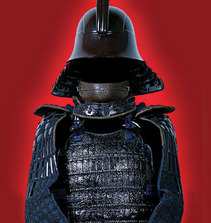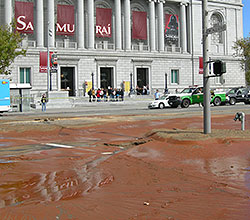 San Francisco’s Asian Art Museum sure has a problem. Last June 12,
San Francisco’s Asian Art Museum sure has a problem. Last June 12,
it opened an exhibition
called Lords of the Samurai, which runs until Sept. 20. It’s the only U.S. venue for a show described in the museum’s press release as:
Through more than 160 objects–armor, weaponry, paintings, lacquer ware, ceramics, costumes, and more–this special exhibition explores the principles that governed the culture of the samurai lords. Nearly all of the objects in the exhibition are from the collection of one of the most distinguished warrior clans, the Hosokawa family. This collection is housed in Japan’s renowned Eisei-Bunko Museum in Tokyo and in the family’s former home, Kumamoto Castle on Kyushu island, Japan. Seven of the artworks on view have been designated Important Cultural Properties, the highest cultural distinction awarded by the Japanese government. Three of the artworks are designated Important Art Objects, another prestigious distinction awarded only to the works of notable artistic and historical significance.
As I understand it, everything was going along well — nice reviews, etc. — until very recently, when someone(s) started a blog parodying the museum’s website. Calling the show “Lord, It’s the Samurai” and labeling the museum “orientalist,” the website — Asians Art Museum — is very clever.
Here’s how it describes the exhibit:
Enter the world of the samurai, where more than seven centuries of martial rule are reduced to a single Disney-like trope of gentleman-warrior myth. Military prowess meets Cultural connoisseurship inan ideal of masculine perfection — selling militarism as beauty in a time of war.
Neither harmless nor innocent, it masks a real history of violence and domination that extends well into the 20th century.
 The website has apparently been picked up by many other blogs, spreading the indignation and embarassing the Asian Art Museum, which it pictures at left as “mired in muck.”
The website has apparently been picked up by many other blogs, spreading the indignation and embarassing the Asian Art Museum, which it pictures at left as “mired in muck.”
I’m rather glad I’m nearly 3,000 miles away.
But here’s the question posed by a reader of Real Clear Arts: what should the museum do? The website, after all, is anonymous, so far — and the curators can’t talk with its creator(s).
In response, the museum has started a blog — an Invitation To A Discussion — on its own website addressing the issues. Not a bad idea.
But is that enough? Too much? Would ignoring the parody have been smart or foolish? Does a small(ish) museum like the Asian Art Museum have to react differently than a big one like the Metropolitan?
Over to you, readers — and over to AJ’s PR expert, Amanda “Life’s A Pitch” Ameer, who just posted on blog etiquette, which is close enough.
Photo Credits: Courtesy of the Asian Art Museum (top) and Asians Art Museum (bottom).
